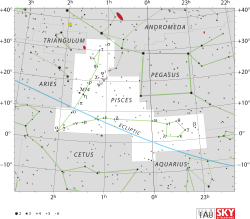Delta Piscium

|
| Observation data Epoch J2000.0 Equinox J2000.0 | |
|---|---|
| Constellation | Pisces |
| Right ascension | 0h 48m 40.953s[1] |
| Declination | +07° 35' 6.20"[1] |
| Apparent magnitude (V) | +4.43 |
| Distance | 305 ly (93.545 pc) |
| Spectral type | K5III |
| Other designations | |
Delta Piscium (Delta Psc, δ Piscium, δ Psc) is a binary star in the constellation Pisces, with an apparent magnitude of +4.43. The primary component is an orange K-type giant. It is approximately 305 light years from Earth. The temperature seems well-defined at 3975 Kelvin, which (to account for a lot of infrared radiation) with distance tells of a luminosity 380 times that of the Sun.[2]
Delta Piscium is moving through the Galaxy at a speed of 54.2 km/s relative to the Sun. Its projected Galactic orbit carries it between 21,700 and 26,100 light years from the center of the Galaxy.[3]
Delta Piscium came closest to the Sun 1.0 million years ago when it had brightened to magnitude 3.96 from a distance of 249 light years.[3]
Naming
In Chinese, 外屏 (Wài Píng), meaning Outer Fence, refers to an asterism consisting of refers to an asterism consisting of δ Piscium, ε Piscium, ζ Piscium, μ Piscium, ν Piscium, ξ Piscium and α Piscium. Consequently, δ Piscium itself is known as 外屏一 (Wài Píng yī, English: the First Star of Outer Fence.)[4]
In fiction
Delta Piscium is the most notable star the moon will be closest to on the solstice of December 21, 2012. Some works of fiction mention Delta Piscium combining myths about the Maya calendar and Revelation 13:5. The forty-two months the beast is to rise to power mentioned in Revelation is marked by the moon's passing Delta Piscium forty-two times. The first passing of this countdown nearly coincided with the full moon on October 4, 2009.